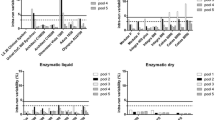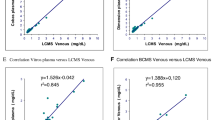Abstract
The purpose of this study was to validate serum creatinine (SCr) concentrations assayed in the Central Biochemistry Laboratory of the National Institutes of Health (NIH)-funded Chronic Kidney Disease in Children (CKiD) study utilizing an enzymatic assay (Siemens Advia 2400) against a method traceable to reference isotope dilution mass spectroscopy (IDMS) developed by the National Institute of Standards and Technology (NIST). High-performance liquid chromatography (HPLC) measured SCr after external validation utilizing IDMS-based standard reference materials. Sera from the first 201 subjects enrolled in CKiD were analyzed and compared for creatinine concentration by enzymatic and HPLC methods. Fifty “normal” pediatric sera were subsequently analyzed. Finally, a “pediatric” reference standard was prepared and examined for accuracy and precision. Enzymatic SCr concentrations (median 1.4 mg/dl) of CKiD subjects were well correlated with HPLC (r = 0.984) but were slightly higher (+7%; p < 0.001). Agreement was poorer at lower SCr (median 0.4 mg/dl) when using samples from normal children and the “pediatric” reference standard. However, the Roche enzymatic assay was comparable with HPLC in accuracy and precision. Referring physicians should be aware of the accuracy and reproducibility of their laboratory’s SCr assay. Our enzymatic assay agreed well with HPLC in CKiD subjects with elevated SCr. We suggest that NIST develop a pediatric SCr standard reference material for use by assay manufacturers to improve accuracy and precision of assays at the low SCr levels observed in most pediatric patients.




Similar content being viewed by others
References
Schwartz GJ, Brion LP, Spitzer A (1987) The use of plasma creatinine concentration for estimating glomerular filtration rate in infants, children, and adolescents. Pediatr Clin North Am 34:571–590
Hogg RJ, Furth S, Lemley KV, Portman R, Schwartz GJ, Coresh J, Balk E, Lau J, Levin A, Kausz AT, Eknoyan G, Levey AS (2003) National Kidney Foundation’s kidney disease outcomes quality initiative clinical practice guidelines for chronic kidney disease in children and adolescents: evaluation, classification, and stratification. Pediatrics 111:1416–1421
Myers GL, Miller WG, Coresh J, Fleming J, Greenberg N, Greene T, Hostetter T, Levey AS, Panteghini M, Welch M, Eckfeldt JH (2006) Recommendations for improving serum creatinine measurement: a report from the Laboratory Working Group of the National Kidney Disease Education Program. Clin Chem 52:5–18
Levey AS, Bosch JP, Lewis JB, Greene T, Rogers NL, Roth D (1999) A more accurate method to estimate glomerular filtration rate from serum creatinine: a new prediction equation. Ann Intern Med 130:461–470
Schwartz GJ, Haycock GB, Chir B, Spitzer A (1976) Plasma creatinine and urea concentration in children: normal values for age and sex. J Pediatr 88:828–830
Keppler A, Gretz N, Schmidt R, Kloetzer HM, Groene HJ, Lelongt B, Meyer M, Sadick M, Pill J (2007) Plasma creatinine determination in mice and rats: an enzymatic method compares favorably with a high-performance liquid chromatography assay. Kidney Int 71:74–78
Ambrose RT, Ketchum DF, Smith JW (1983) Creatinine determined by “high-performance” liquid chromatography. Clin Chem 29:256–259
Bland JM, Altman DG (1986) Statistical methods for assessing agreement between two methods of clinical measurement. Lancet 1:307–310
Huang YC, Chiou WL (1983) Creatinine XII: comparison of assays of low serum creatinine levels using high-performance liquid chromatography and two picrate methods. J Pharm Sci 72:836–837
Miller WG, Myers GL, Rej R (2006) Why commutability matters. Clin Chem 52:553–554
Acknowledgments
The CKiD is funded by the National Institute of Diabetes and Digestive and Kidney Diseases, with additional funding from the National Institute of Neurological Disorders and Stroke, the National Institute of Child Health and Human Development, and the National Heart, Lung, and Blood Institute (UO1-DK-66143, UO1-DK-66174, UO1-DK-66116). The CKiD Web site is located at https://doi.org/www.statepi.jhsph.edu/ckid. The clinical coordinating centers (principal investigators) are at Children’s Mercy Hospital and the University of Missouri – Kansas City (Bradley Warady, M.D.) and Johns Hopkins School of Medicine (Susan Furth, M.D., Ph.D.), and the data coordinating center (principal investigator) is at the Johns Hopkins Bloomberg School of Public Health (Alvaro Muñoz, Ph.D.), with the Central Biochemistry Laboratory at the University of Rochester (George J. Schwartz, M.D.). We are grateful to Ms. Paula Maier of the CBL for her excellent assistance in coordinating this study.
Author information
Authors and Affiliations
Corresponding author
Rights and permissions
About this article
Cite this article
Schwartz, G.J., Kwong, T., Erway, B. et al. Validation of creatinine assays utilizing HPLC and IDMS traceable standards in sera of children. Pediatr Nephrol 24, 113–119 (2009). https://doi.org/10.1007/s00467-008-0957-0
Received:
Revised:
Accepted:
Published:
Issue Date:
DOI: https://doi.org/10.1007/s00467-008-0957-0




